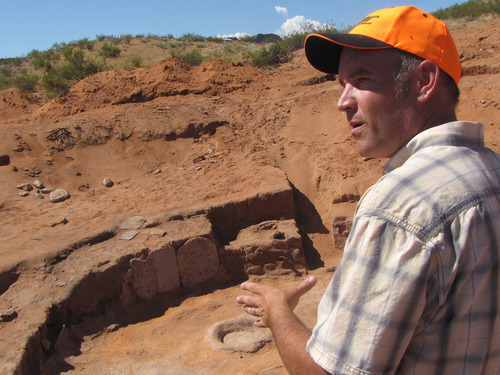This is an archived article that was published on sltrib.com in 2011, and information in the article may be outdated. It is provided only for personal research purposes and may not be reprinted.
Washington City • Areas containing pit houses and food storage structures in five Ancestral Puebloan settlements in southern Utah are being studied by teams of archaeologists outside Washington City before a new highway goes through the area of sugary red sand.
Digs that began in April just north of the southwestern Utah city by archaeologists under contract to the Utah Department of Transportation will document the sites before they are reburied and new segments built for the Southern Parkway (State Road 7).
A completed portion of the highway provides access to the new St. George Municipal Airport. When finished, the road will connect I-15 south of St. George to Hurricane.
Eric Hansen, an archaeologist and environmental specialist for the Dixie Division of UDOT, said the latest sites suggest cultures dating from 2,000 to 800 years ago. Artifacts and building materials collected at the sites are still being analyzed to establish when people occupied the area.
He said the pit houses are partially sunken into the ground and have flagstone floors and walls. But posts placed inside the houses that once supported roofs are long gone.
The site overlooks the valley where Washington City is nestled, providing a strategic advantage to the pit house dwellers who had broad views of the surrounding area. They were close to the Virgin River, which helped irrigate the corn, beans and squash they grew and provided the silty mud for dwellings and ceramics.
The pit houses, all with round-shaped hearths in the center and stone benches along some walls, provided shelter for small family networks.
Hansen said the sites were discovered because the location made them logical settlement areas and there was evidence of stone flakes and pottery sherds on the surface.
One of the five sites being investigated is older than the others, Hansen said. No evidence of ceramics was found in the pit houses there, leading scientists to believe it was created about 2,000 years ago, before pottery was produced. They also found stone points that were likely used for a spear-throwing tool called an atlatl rather than for arrow heads.
"We believe this site could predate the bow and arrow," Hansen said.
The other sites being investigated apparently were developed by later cultures because of arrow points and ceramics found there. The area could have been occupied until A.D. 1250, said Hansen.
Artifacts collected at the sites will be sent for further study to the Utah Museum of Natural History in Salt Lake City and Southern Utah University in Cedar City.
An archaeological inventory of the sites, which are on Bureau of Land Management property, is required under the National Historic Preservation Act.
Archaeologist Erica Young of Cedar City-based William Self Associates, which has the contract to conduct the survey, took notes at one site under a blazing sun Tuesday. She said the team she was with is now digging exploratory trenches below the floor levels of uncovered structures to see what might lie beneath.
Hansen said 17 archaeological sites have been uncovered, studied and incorporated in the final decision for the road's alignment, which will cover about 30 miles.
"Due to the high number and nature of sensitive sites in the area, UDOT realigned a portion of the Southern Parkway five times to avoid major sites," said Hansen.
He said one set of ancient remains was discovered and will be handled according to provisions of the Native American Graves Protection and Repatriation Act.
Dana Meier, the program engineer for UDOT's Dixie Division, said construction on the two-lane highway could begin this fall. The completion date is not yet known.
He said the project has been in the works for nearly two decades and is designed to handle projected growth in the area.
"We want to avoid a bottleneck on I-15," said Meier.
A UDOT spokesman said that leaders of the Hopi and Paiute tribes have agreed to the plans.
A member of the Shivwits Band of Paiutes in Washington County is serving on the project's archaeological team.



